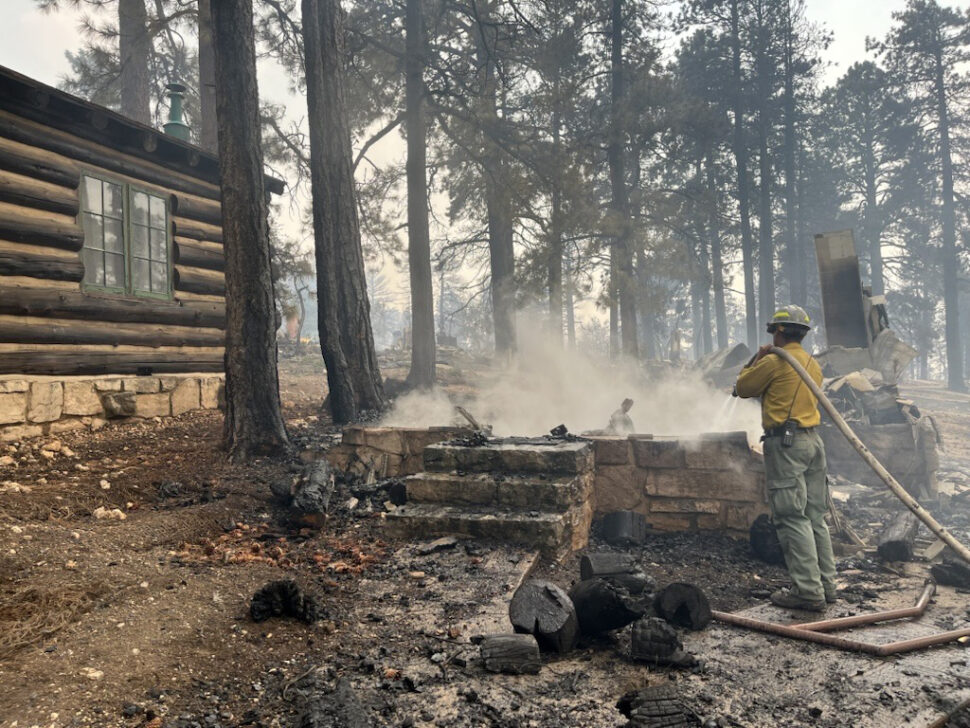A fast-moving wildfire is currently tearing through the North Rim of Grand Canyon National Park, forcing evacuations, shutting down major tourist areas and destroying one of the park’s most historic landmarks. Known as the Dragon Bravo Fire, the blaze was sparked by lightning and has rapidly grown due to high winds and extreme drought conditions.
As fire crews work around the clock to contain the flames, travelers with plans to visit the Grand Canyon this summer are being urged to stay informed. With closures, air quality concerns and widespread damage unfolding in real time, here’s what you need to know about the fire, what’s at risk and how it could affect your trip.
What Started The Grand Canyon Fire?
The Dragon Bravo Fire ignited on July 12, 2025, after a series of dry thunderstorms moved through northern Arizona. Smoke was first reported near the North Rim of Grand Canyon National Park, in a remote area known to firefighters as Dragon Bravo. With extreme drought conditions and dry vegetation, the fire spread rapidly overnight.
By the morning of July 13, the fire had intensified significantly. High winds pushed flames toward the historic Grand Canyon Lodge, prompting immediate evacuation orders for guests and staff. Fire crews and park rangers worked swiftly, but the fire reached the lodge by late afternoon. That evening, flames engulfed much of the structure, destroying large portions of the iconic building.
In the following days, firefighting teams deployed helicopters and ground crews to contain the blaze. By July 15, officials reported partial containment, though smoke and hotspots remained a concern. The fire led to widespread closures throughout the North Rim, with ongoing assessments of environmental and structural damage.
What Else We Know About The Dragon Bravo Fire
Reuter reports that the fire ignited on July 4 by lightning and has since consumed approximately 8,570 acres (roughly 13 square miles) near the North Rim. Over 50-80 structures have been destroyed, including the historic Grand Canyon Lodge, park staff housing, cabins, visitor centers, administrative buildings, a water treatment plant and a wastewater facility, per People. No injuries or fatalities have been reported. Thanks to timely evacuation orders, all park staff, guests and nearby residents were safely removed from the area.
The North Rim is fully closed for the remainder of the 2025 season (typically runs May 15 - Oct 15). All visitor services, including lodging, campgrounds, ranger programs, gas stations, visitor centers and inner-canyon trails (e.g., North/South Kaibab, Bright Angel, Phantom Ranch), are unavailable according to CN Traveler. The South Rim, however, remains open but is under Stage 1 fire restrictions due to high fire danger. Visible smoke may affect air quality and visibility, which is something to keep in mind if you’ll be in the area.
AP News reports that as of July 15, both the Dragon Bravo Fire and the nearby White Sage Fire remain 0% contained and continue to spread. Several hundred firefighters and specialized teams (including a Complex Incident Management Team) are engaged in active containment efforts.
What Hotel Burned In The Grand Canyon?

The Dragon Bravo Fire completely destroyed the Grand Canyon Lodge on the North Rim, an iconic structure built between 1927 and 28, designed by notable architect Gilbert Stanley Underwood using Kaibab limestone and ponderosa pine. The original lodge burned in 1932 and was rebuilt in 1936–37 on the same foundation. In 1987, the building was declared a National Historic Landmark.
Park officials are currently focused on full containment and damage assessment. There is no set timeline for rebuilding or reopening. Grand Canyon Historian, Davy Crockett, gave an interview to KSL stating, “Those of us who know people there just have the faith and understanding that they’re going to do everything they can to see that that can be rebuilt.”
National Park Service Defends Its Handling Of The Blaze
Officials initially managed the Grand Canyon fire as part of a “confine and contain” strategy, allowing it to burn naturally under supervision to support forest health. The strategy shifted to full suppression only after the fire grew exponentially amid strong winds on July 11-12. Reuters explains that Arizona Governor Katie Hobbs and state congressional leaders demanded an independent federal investigation, accusing the National Park Service of treating the fire like a controlled burn during peak summer heat and extreme dryness.
The Park Service maintains that its measured approach was based on fire ecology and safety. Still, atypical nightly winds rapidly upended their plans, forcing a response shift only when suppression became urgent. Kevin Sweeney with NPS fire management defended the Park Service’s action to AZ Family. “When this fire happened, it was in the evening time and we can’t fly resources at night. We can’t put air attack in harm’s way by flying them at night,” he said.
Frequently Asked Questions
How old was the Grand Canyon Lodge?
The Grand Canyon Lodge was nearly a century old. Originally opened in 1928, it had been a designated National Historic Landmark and a key part of the Grand Canyon experience for generations of visitors.
Who owns the Grand Canyon Lodge?
The lodge is federally owned and located within Grand Canyon National Park, but it was operated by Forever Resorts under a concession contract with the National Park Service. The company managed lodging, dining and guest services.
How many tourists have fallen in the Grand Canyon?
On average, 2-3 tourists accidentally fall into the Grand Canyon each year, though overall park fatalities range from 10-15 annually. Many incidents are linked to dehydration, heat or risky behavior near the edge while taking photos or hiking off-trail.





